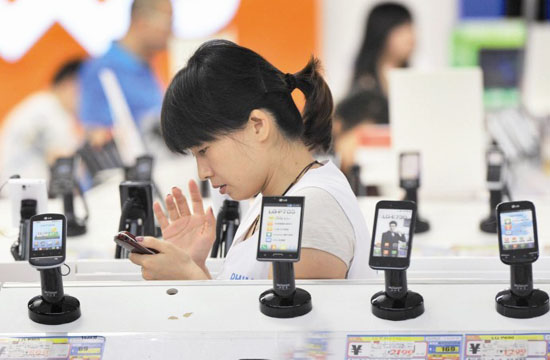|
 |
|
Various smartphones on show at a store in Nanjing, the capital city of East China's Jiangsu province. Both Chinese telecommunication and banking companies are targeting the near field communication as a new business engine for growth. This is a technology for smartphones and similar devices that establishes radio communication with each other by touching them together or bringing them into close proximity. [Photo/China Daily] |
Interest grows in using mobile phones to pay at the checkout
When tourists visit Singapore, they will soon find some Singaporeans are using mobile phones to complete daily transactions. When they buy drinks at a food court, take a taxi or go shopping in stores such as Watsons, they just tap and pay using their near-field-communication-enabled mobile devices.
The paying process is fast, convenient and cash-free. It is based on a technology that has received increased attention worldwide over the past three years, although it first emerged as early as the 1980s.
NFC is a short-range communication technology like Bluetooth but is slower, less energy-intensive, requires closer proximity and does not need pairing.
One of the most popular NFC applications is to help people complete payments through mobile devices. An NFC-enabled mobile takes on the role of a digital wallet that allows users to pay for goods, travel and tickets, transfer money and receive promotional offers and store loyalty points.
In Singapore, consumers have the freedom to tap and pay at more than 20,000 retail points such as convenience stores, fast food outlets and even a fleet of taxis.
"China may learn from the NFC project in Singapore," said Michael Au, Asia senior vice-president of Gemalto NV. Gemalto, a France-based digital security company, has provided the fundamental NFC services management for the whole Singaporean NFC project.
The NFC project in Singapore was promoted by the Singaporean government and backed by local partners including mobile operators, banks and service providers. "It builds a unified, comprehensive central management platform, which avoids much new construction," said Au.
Many other countries, including Italy, France and the United Kingdom, have conducted NFC trials in recent months. South Korea and Japan, in particular, have been the frontrunners as these two Asian countries have been initiating large-scale NFC trials by providing diversified applications since last year, Au said.
As a mainstream mobile payment technology, NFC also received a warm welcome in China and its adoption is gaining momentum. China Mobile Ltd, the world's biggest telecom carrier by subscriber numbers, said it planned to sell more than 10 million NFC-enabled mobile phones, based on its TD-SCDMA 3G network, next year. Meanwhile, the operator hopes to attract 3 million NFC service providers during the same period.
"We are about to officially start the commercial rollout of NFC services in 2013," said Xiong Hui, deputy general manager of China Mobile's e-commerce department. He was speaking during the GSMA NFC Mobile Money Summit held in Milan at the end of October.
Previously, China Mobile and the nation's bankcard organization China UnionPay Co had signed a cooperation agreement on collectively providing NFC services. The two companies plan to build 100 NFC service demonstration sites in 50 Chinese cities.
Under its plan, China Mobile will be responsible for customer development while China UnionPay will take care of finding service providers, as well as the deployment of point-of-sale machines across the country.
In September, China Merchants Bank Co, or CMB, and the Taiwanese cell phone manufacturer HTC Corp together released the mobile-payment product called "CMB wallet".
The "CMB wallet", based on NFC technology, can be used to make small-sum payments. CMB is planning to make it capable of processing large payments - those involving as much as 50,000 yuan ($7,900), for example - next year, said Liu Jianjun, director of the bank's retail finance headquarters.
"The increasing number of NFC mobile phones will help push forward the development of mobile payment in China," said Au from Gemalto. In addition to HTC, other mobile phone vendors such as Samsung, Huawei and Lenovo have all launched NFC incorporated handsets.
According to a report issued by New York-based company ABI Research, the market volume of the world's NFC mobile payment industry could exceed $100 billion by 2016, up from $4 billion this year. The Chinese market may have a mobile payment user base of 387 million by 2014, with a transaction volume of 385 billion yuan in the same period, said Beijing-based research firm Analysys International.
However, there are also barriers to rapid NFC development. Angel Dobardziev, an analyst at Ovum, said the telecom industry has a shared vision of what successful mobile money services will look like in the future and what user experience they will provide.
"But it is less clear how the industry will reach this vision, including how it will address the problem of convincing retailers and users to embrace on-premise payments," Dobardziev said.
"Most retailers and consumers are yet to embrace mobile paymentsThis is largely because of a classic 'chicken and egg' scenario," Dobardziev added. Users are not looking for NFC-enabled devices as there are still relatively few retail outlets in which to use them and retailers are not enthusiastic about investing in NFC point-of-sale equipment as few users are demanding it, she said.
shenjingting@chinadaily.com.cn
